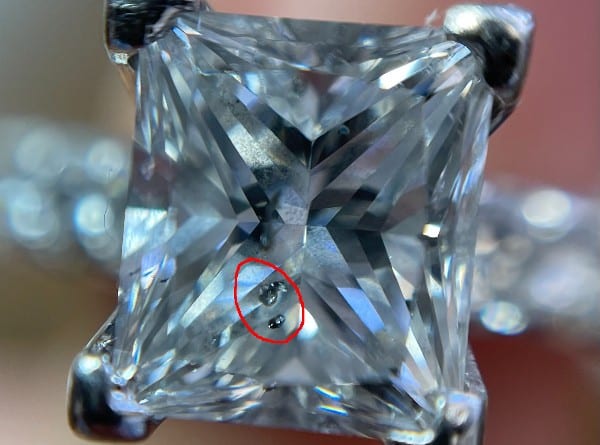What exactly are diamond inclusions, and how do the different types of inclusions affect the quality, aesthetic appeal, and price of a diamond piece? Below is a comprehensive guide to the world of diamonds and stone impurities.
WHAT ARE INCLUSIONS?
As diamonds gradually form naturally, most will contain an inclusion or impurity at one point through the complex structure. The best way to think of inclusion is like a diamond birthmark or defining feature. These features are commonly referred to as blemishes and can be found on the precious stone’s surface.
When it comes to the 4 C’s of Diamonds the inclusions most have to do with diamond clarity.
On the surface, an inclusion may appear like a flaw. However, this is rarely the case as these inclusions add to the diamond’s uniqueness. Many people understand inclusions as the black marks seen on precious stones.
The black spots only form a small part of diamond inclusions. The black specs are crystals made up of carbon found within the diamond. In reality, there are countless types of diamond inclusions formed as the diamond gradually forms. The various types of inclusions form differently, meaning each will have a unique effect on the clarity and appearance of the stone.
As noted earlier, inclusions are not necessarily a bad thing when it comes to diamonds. In fact, the American Gem Society (AGS) and the Gemological Institute of America (GIA) will still grant certifications to diamonds with various types of inclusions.
TYPES OF DIAMOND INCLUSIONS:
Diamonds can have any number of unique inclusions. Each of these could be unique and formed at a different time as the precious rock was developing. The various types of diamond inclusions are;
Bearding
Bearding inclusions are largely artificial and are added when the precious gem is being cut. These inclusions appear like gray, fuzzy hair-like lines and form at the girdle. Bearding can be reduced when working with a skilled diamond cutter and quality equipment. Diamond with significant bearding inclusions may appear blurry at the girdle.
Laser drill hole
The aforementioned black inclusions can be removed with the help of a laser. However, as the laser drills through the gem, it could leave microscopic inclusions. These laser drill hole inclusions are not visible to the naked eye, although they can still affect the final value of the diamond.
Cavity
Cavity inclusions are formed as the stone is being polished. Just like a tooth, the polishing could dislodge some material and leave a gap or cavity. Most diamond experts advise you to leave the cavity as is since removing it will reduce the stone’s carat. The cavity will often fill up with dirt and oil, which some people see as a mark of authentic stones.
Crystal
Crystal inclusions are basically the presence of external crystals inside the diamond. These crystals can be any color and largely depend on the minerals present as the diamond was forming. Black carbon crystals, green peridot crystals, and red garnet crystals are just a few examples of this inclusion type.
Pinpoint
These are tiny black or white crystals formed within the diamond and appear like dots under magnification.
Cloud
A cloud inclusion is a term used to generally classify a collection of crystals or pinpoint inclusion found close to each other. Cloud inclusions can have a significant effect on the diamond’s final appearance.
Other types of diamond inclusions are:
- Feather inclusions
- Natural inclusions
- Indented natural inclusions
- Bruise inclusions
- Needle inclusions
- Etch channel inclusions
- Knot inclusions
- Twinning wisp inclusions
- Chip inclusions
ARE DIAMOND INCLUSIONS A BAD THING?
Evidently, there are numerous ways a diamond can form inclusions, both in the formative stages and when it’s being handled or prepared for sale. However, these inclusions are not necessarily undesirable features of the precious stone.
The effect an inclusion will have on a diamond depends on various factors. For example, if the inclusion is not visible to the eye and doesn’t alter the diamond’s appearance, it will have little effect on the stone’s quality. On the flip side, if the impurity is visible to the naked eye, it may drive down the overall quality and price.
Nonetheless, inclusions remain a large part of precious stones. In fact, in large pieces, these inclusions are welcomed as they signify a defining feature. And as long as the inclusion doesn’t compromise the stone’s durability or appearance, many diamond enthusiasts will welcome its presence.


